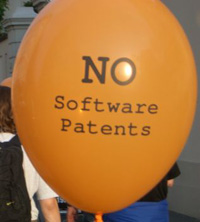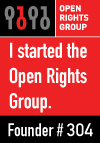Landmark software patent ruling in the UK
 Back in November2007 I briefly commented on a case making its way to the High Court of England and Wales dealing with software patents. We now have a decision, and it may prove to be quite an important shift in the practice at the Intellectual Property Office.
Back in November2007 I briefly commented on a case making its way to the High Court of England and Wales dealing with software patents. We now have a decision, and it may prove to be quite an important shift in the practice at the Intellectual Property Office.
The case is Astron Clinica Ltd & Others v The Comptroller General of Patents, Designs and Trade Marks [2008] EWHC 85 (Pat) . The ruling is particularly important as it was believed by many (myself included) that Aerotel was the final word with regards to software patentability. Those who follow the software patent debate, may recall that the IPO issued a set of guidelines arising from Aerotel which pretty much discourage outright software patent applications in the UK. This was not in line with practice at the EPO, or so it was believed by various parties which favour the patentability of software as such. This opinion was shared by a number of software developers, which then issued an appeal against the rejection of six separate patent applications made to the IPO. These applications had three things in common. They all represented claims for methods, devices and software. Examiners found that the claims on methods and devices were patentable, but that the software "as such" was not, based on the aforementioned guidelines and on the Aerotel ruling. What were the claims in those applications? I will quote from the ruling:
"Software 2000 has developed a method of generating bit masks for use with laser printers which results in higher quality images. It is implemented by programming a conventional computer, printer or copier to process images in a particular way. Software 2000 exploits its invention by selling the program to its commercial partners who then incorporate it in their printers and printer drivers, and distribute it to end users in the form of printers, computer discs and web downloads. The end users are located worldwide.As you can see, the claims are all very similar in the fact that there is a clear executable element to the invention. All of the applications relate to some form of software which runs on a device, be it printer, computer or mobile phone, which somehow improves the actual functionality of the recipient. The question facing the court was therefore whether the executable element is subject to patent protection. The answer is negative after Aerotel, but it also should be negative if one reads strictly Art 52(3) of the European Patent Convention, which clearly says that computer programs as such are not an invention. The problem has been that the practice at the EPO after various cases has been to allow patentability of executable computer programs, this has been repeatedly seen in various EPO Boards of Appeals cases (see T 1173/97, and most recently, T 0411/03).
Astron Clinica was founded to commercialise skin imaging techniques developed at the University of Birmingham which enable images of the skin to be processed to identify the distribution and concentration of underlying skin chromophores. The invention described in its application provides a system and process for generating realistic images representing the results of planned cosmetic or surgical interventions which change the actual or apparent distribution of these chromophores. The invention is implemented by programming a computer to process images in a particular way. It is commercialised here and abroad by selling a disc which causes a computer to be configured so as to undertake the required processing.
Inrotis is a spin-off company established by the University of Newcastle upon Tyne to commercialise drug discovery and network analysis techniques. Broadly speaking, the inventions the subject of its two applications in issue concern methods of identifying groups of target proteins for drug therapy by processing proteome data defining proteins and protein interactions. The commercial product which Inrotis sells is a computer disc which causes a computer to be configured so as to carry out the necessary processing.
SurfKitchen is a mobile services company and has made an invention which improves the ability of mobile telephones to access services on the Internet. It is implemented by pre-storing a program on a mobile telephone memory or by downloading the program from the Internet. In either case the program is usually made available by one of SurfKitchen's commercial partners to whom it makes the program available on a computer disc.
Cyan Technology is a semi-conductor company which designs and builds microcontrollers. It has invented a method of generating data for configuring microcontrollers which greatly simplifies chip design and programming. The commercial products that implement the invention are computer discs and Internet downloads which cause a computer to be configured so as to undertake the required processing. Cyan Technology distributes these computer discs and Internet downloads worldwide."
The ruling has an extended section detailing existing legislation and case law, which I will ignore, as it is a common thread along these rulings. The meat of the matter however, is whether Kitchin J will agree with Aerotel and Jacob J in continuing the separate practice at IPO and EPO. I agree completely that the UK has been developing a completely different doctrine to that at the EPO with regards to software patentability, but I disagree that this is a bad thing. I have to say that I strongly believe that the various cases dealing with software patents in recent years had it right when it comes to analysing whether software as such is subject to patent protection. Jacob J clearly was not amused with the mental gymnastics exhibited by the EPO Board of Appeals to try to conveniently ignore the fact that the wording of Art 52(3) does not say what it clearly says. To be able to do this, the EPO invented the contrived and unworkable concept of "technical contribution", which does not exist in the legislation.
Unfortunately, Kitchin J decided that the split with the EPO should end. He claims to have read Aerotel closely, and he rightly points out that nothing in that decision prohibits the patentability of computer programs as such. He takes this as the permission needed to get back into EPO practice. He comments:
"... I do not detect anything in the reasoning of the Court of Appeal which suggests that all computer programs are necessarily excluded. I have identified the key aspects of the decision which relate to computer related inventions and they undoubtedly criticise the reasoning of the EPO Board of Appeal in each of the "trio" of cases. But the criticism is directed at the "any hardware will do" approach and the return to form over substance with the drawing of a distinction between a program as a set of instructions and a program on a carrier."This is all the permission he needs, computer programs are back in the menu. He reasons:
"... it is highly undesirable that provisions of the EPC are construed differently in the EPO from the way they are construed in the national courts of a Contracting state. Moreover, decisions of the Board of Appeal are of great persuasive authority. In the light of Aetotel/Macrossan it is not open to this court to follow the decisions in the "trio". However the new approach can be interpreted to produce a result consistent with that obtained by applying the reasoning of the Boards of Appeal in IBM/Computer Program Product T1173/97 and IBM/Computer Program Product II T0935/97 - decisions which, I would add, are still followed in the EPO as shown, for example, by the decision of the Board of Appeal in Tao Group Limited (2007) T121/06."While I can see the reasoning behind it, I have to say that this is an unfortunate decision. In my opinion, the wording of Art 52(3) of the EPC is more than clear, and ensuing cases have tried very hard to ignore the fact that it is very clear and unequivocal in order to allow for the patentability of computer programs. It is not up to the EPO Board of Appeals and the courts to change the wording of the treaty. Why not get it over and done with and actually push for amendment to the actual letter of the law?
You can see some thought on the case and an interesting series of comments at IPKat.

 del.icio.us
del.icio.us




No comments:
Post a Comment